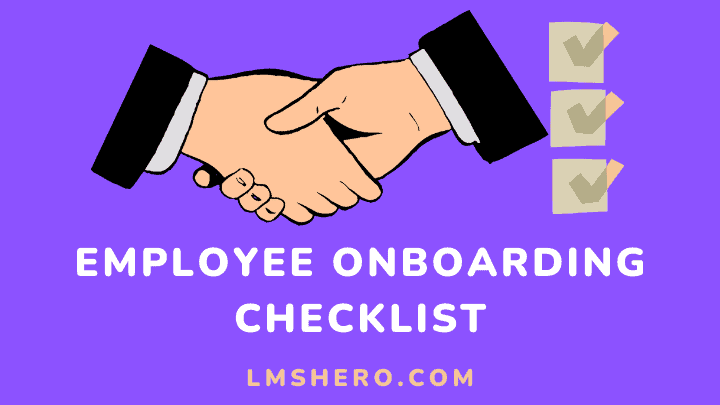You’ve done the hiring, screened a thousand resumes, and gone through a few rounds of interviews. Now comes the hard part: keeping your new hires around.
With the right employee onboarding checklist, you can make sure your new hire has an excellent first impression of your business.
Your employees’ first days are crucial to making a great impression and educating them on your company’s objectives, mission, and culture.
Put your team right to work. This starter kit provides an easy, step-by-step guide to help you get employees up and running on everything they need to be productive. It’s designed for both employees and managers, so everyone knows what to do next.
It’s time to get organized if you’re trying to improve your company’s onboarding. Here is a great employee onboarding checklist for you.
What is Employee Onboarding?
It is fairly safe to assume that before hiring a new employee, you have already undertaken an employee background check.
Thus, employee onboarding is the process of integrating a new employee with a company and its culture. Furthermore, it is a way of getting a new hire the tools and information needed to become a productive member of your team.
The success or failure of an employee may depend on the manager and co-workers. So it’s important to make new hires feel welcome in their new role and that’s where an employee onboarding checklist can be invaluable.
Keep track of what’s needed, who’s responsible for what, and when it needs to be done by using an onboarding checklist. The following is a complete checklist for employee onboarding.
1. Give New Employee(s) a Tour of the Workplace or Facility
Hopefully, the new employee(s) will see the physical building for the first time and be excited to begin a new position.
Give them a general tour of where they’re allowed to go—the office space, restrooms, cafeterias, kitchen areas, etc.
Also, point out and label any important rooms where fire exits exist, hazmat storage rooms, and so on.
New employees often feel overwhelmed on their first day at a new workplace. A physical layout of the building or a personalized tour, can ease some of that stress and help them get settled in.
If a new employee starts on day one, it’s in your best interest to introduce them to their new working environment before their first day even starts.
First impressions are important, and the last thing you want is for a team member to show up without knowing how to get to their desk.
Provide new employees with badges or key access cards so they can move around easily and don’t feel like they are intruding.
2. Introduce New Employee(s) To Team Members
Introducing a new employee to his/her new team members is an important step in the onboarding checklist process.
A company is only as good as the team it’s built off of, so it’s essential that new employees feel welcomed and appreciated.
Consider having the entire team meet for lunch when the new employee(s) join.
You want to make sure that your new hire feels welcomed and accepted at their new job. So don’t overlook this important step in the onboarding process.
When done right, it can do wonders for setting up your new employee for success and making them feel like they are a crucial part of the team.
Also, the more time a new employee spends with his colleagues, the more he will feel confident in his surroundings.
3. Emphasize the Company’s Value
In a new employee’s first days on the job, they’re probably meeting many people and trying to learn their way around. At the same time, you want them to be comfortable and excited about working for your company.
It’s important that you make your company’s mission clear. You should emphasize its core values, encourage creativity and exploration, and praise accomplishments. You wish all new employees would be fit, motivated, and enthusiastic.
But let’s face it; many of them don’t. Onboarding checklists help your new team members understand how important their role is for the company and how much fun it can be.
4. Set Up Employee Computer, Software, And Account Access
New employees can make or break a team. Also, if you don’t take the time to effectively onboard them, your odds of starting on the right foot are slim.
So let’s break it down and start with one of the things that are most often skipped but definitely should not be skipped: setting up your new employee.
As soon as you can, get your new hire a computer with all the hardware and software they need. Make sure they have access to any important accounts and files.
If possible, order new business cards for them. This will also help people immediately recognize their new role at your company.
5. Introduce New Employee(s) To the HR Department for the Necessary Paperwork
One of the most important parts of your onboarding process is making sure all the necessary paperwork is ready before the new employee’s first day.
HR must have this information as soon as possible so that this step is a breeze for you.
With a new employee comes plenty of forms to fill out and information to give, so new employees will be introduced to the HR department first.
After their paperwork is filled out, they’ll meet with the hiring manager for a more detailed overview of the expectations for their position.
6. Provide formal training
An employee’s first day at a new job is both exciting and challenging.
As an employer, you’re already aware of this. This is why onboarding new employees are vital for the development of your business.
It will also help you establish organizational goals, communicate expectations, and make your employees feel welcome.
To educate your employees and have them contribute to the company in meaningful ways, you need to be transparent with your expectations.
Create a new employee training schedule that all new employees must go through before they start, so they can learn the necessary skills and contribute to optimal performance.
7. Show How To Use Different Equipment/Tools/Products
To relieve some of the new hire stress, you can help your newest team members by showing them how to use different equipment, tools, and products. This could also include anything from computers to coffee machines to different software you use in the office.
If there is anything specific to your industry or company, it would be helpful for new employees to know how to use it properly. Don’t forget to explain how to use any equipment and products they will be using daily.
If a new employee is not confident in using the equipment or tools, it will slow them down and add further pressure.
Not only does this reflect well on your company, but it will also ensure new employees are ready to carry out their responsibilities and duties.
8. Assign a Peer Mentor
New employees can be overwhelmed with information coming at them from all directions. A peer mentor can help by being an ally to the new employee and a point of contact for questions about the new job.
A great onboarding checklist for businesses includes assigning a peer mentor to the new employee within their first week of work.
A peer mentor is a great way to help new employees manage their initial expectations of a new role and company.
Outline the goals, initiate an understanding of the company culture, and develop a sense of belonging. A peer mentor can also serve as an important resource in helping new employees adjust to their day-to-day tasks.
Peer mentors are competent employees who are good at communicating, patient, and approachable. Great candidates are employees who want to stay in their position for the long term.
They should be enthusiastic about their jobs and the company as a whole. Through this and new employee orientation, your employees will develop a sense of belonging and begin a dialogue with you.
9. Take Time to Listen And Answer Questions
Onboarding is an important process for every business but can be especially confusing and frustrating for a new employee.
The first day of a new job can be stressful and overwhelming. For new employees, it is important to discover new ways of working, meet their teammates, understand expectations, and develop their work plans.
Providing the right information during the onboarding process reduces the amount of uncertainty, allowing your new hires to quickly get ramped up to productivity.
The more time you spend explaining processes and answering questions, the faster and easier it will be for that new employee to get up to speed.
Also, as the employee gets more comfortable, it’s important to allow time for questions. Encourage them to ask anything and everything, no matter how small or large the topic may be. If you don’t know the answer, find it together.
10. Employers Should Have Regular Check-Ins to See How They’re Doing
Whether you’re hiring for the first time as a startup or bringing on a large group of employees, every new hire needs to get off on the right foot and develop in their role.
Furthermore, new employee checklists ensure consistency across departments, from safety training to initial office tours.
Having regular check-ins with new hires will help measure the effectiveness of your onboarding program, making sure that new employees have what they need to succeed.
Employees need to know when you plan to check in with them – and when they can expect feedback.
The most common timing is 30 days, 60 days, and 90 days. Creating a 30, 60, and 90-day check-in plan is critical to the success of any new employee. Besides, it gives them time to learn their role and gain confidence in their skills.
It gives managers insight into how well the employee is adjusting to their new role, what challenges they are facing, etc. And it also creates more effective communication between managers and employees.
11. Always Make the First-Day Count
Employers need to make a good first impression on the first day with new employees. This is because the first impression will serve as the basis for the entire relationship between the new employees and their employers.
A good impression will go a long way towards improving the productivity of the new employees and making them feel at home at the workplace.
Some employers have an onboarding checklist that includes items like the introduction of their team, work environment, etc.
FAQs
Why are employee onboarding checklists important?
Employee onboarding is a critical process for new hires. Furthermore, it establishes expectations, increases job satisfaction, and boosts retention for your new employees.
Therefore, employers must create checklists to ensure a smooth transition into the company. This makes the process more efficient and guarantees that nothing important is forgotten.
How to build an employee onboarding checklist?
Make a checklist of things you need to do before your new hire arrives as well as what the employee must do in his or her first days at the company.
Use the checklist not only to set goals, tasks, and deadlines but also to organize important documents and paperwork.
What should an employee onboarding checklist contain?
At the bare minimum, an employee onboarding checklist should include the formalities of onboarding. It should include form I-9 employment eligibility verification, payroll setup, and tax withholding documents.
Additionally, consider adding steps to ensure your new employee gets a good feel for their job, as well as how your company works as a whole.
Final Thoughts
Starting a new job is exciting, but it can also be overwhelming.
I’ve created this checklist to help ease the onboarding process for new employees and their employers. While an employee’s onboarding process differs from organization to organization, there are a few steps to consider at all levels.
The checklist above can be used as a great starting point for any business looking to create an onboarding program.
The points listed are effective, and if incorporated consistently will enable the new hire to quickly become productive.
Did you know that employee referral programs are one of the best ways for employers to hire new employees? By reading the article, you will discover how the process works and why it’s worth the effort.
Thanks for reading.







